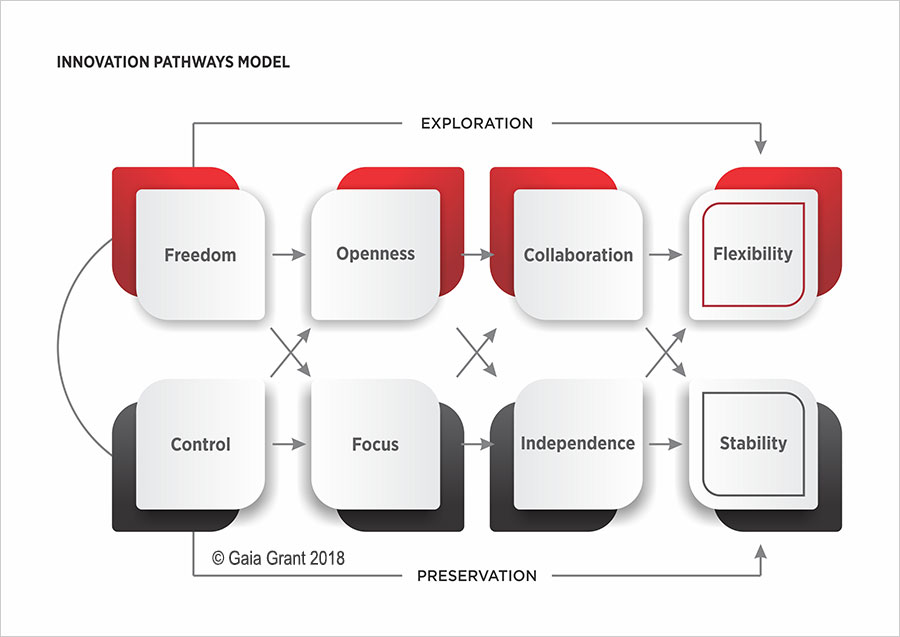
AMBIDEXTROUS ALIGNED & AGILE
How leaders and leadership teams can create a culture that supports innovation and sustainable growth through future-ready leadership approaches
-
AMBIDEXTROUS
Leaders need to be able to balance the competing demands of both
Exploration (future breakthrough thinking) and Preservation (maintaining systems and structures to support growth) for sustainable innovation and growth. Paradoxical cognition, or an awareness of the need to balance both of these orientations simultaneously, is essential for future-ready leadership.WHITE PAPER
What it means to be ambidextrous innovation leader:
For sustainable development in a rapidly changing world
Download:
Available via the download form => -
ALIGNED
Leadership teams can collectively hold the tension between these polar orientations to fuel innovation and growth through magnetic alignment, or having a clear shared core purpose-driven story based on shared values that integrates both simultaneously.WHITE PAPER
Leadership alignment for responsible & purpose-driven innovation:
Dealing with competing demands trhough an integrated shared purpose
Download: Available via the download form => -
AGILE
Leadership teams, and in particular duos, can facilitate a process of building a flexible platform for innovation and growth between the two polar positions through a series of relational practices called here Dynamic Polar Positioning. These practices are a series of reflexive and responsive actions that continue to hold the competing demands in tension effectively through changing contexts.WHITE PAPER
Creating agile leadership teams:
How shared leadership models can better manage the ambiguities of sustainable innovation and growth
Download: Available via the download form =>
- These White Papers looks at the importance of organisations and their leaders being “ambidextrous”
- It is based on Gaia Grant's research with the Discipline of Strategy, Innovation and Entrepreneurship at the University of Sydney Business School
- The white paper is a result of interviews with 70 Heads of Innovation globally, along with year-long immersion case studies, and the analysis of over 1000 survey responses
- Along with the iCLi Innovation Change Leader assessment developed from this research it is now possible to identify leadership ambidexterity for individuals (try it here )
DOWNLOAD THE WHITE PAPERS

What it means to be an ambidextrous innovation leader: Developing greater agility for sustainability in a rapidly changing world
Rapid change and complex contemporary environments require quick adaptive thinking. Yet ironically these complex environments can also lead to tension, which make it difficult to innovate and progress effectively.
Leaders of the future will be required to develop ambidextrous responses to deal with complexity and rapid change at all levels. That is, they will need to know how to recognise and effectively navigate competing demands to stay ahead, although they are better resourced to respond to paradoxes once the specific tensions have been identified and addressed, leaders are often ill-prepared for identifying and dealing with them.
This paper reveals how it is possible to develop greater flexibility & agility.
VIDEO: The Paradox of innovation and sensemaking - VIEW...
The Paradoxical Innovation Process: The value of synthesising the paradoxes. Understanding the challenges of innovation journey, from imagination and ideation to implementation. Gaia looks at four key paradoxical pairings related to the exploration/exploitation tension that have been identified as needing to be resolved at each stage of the innovation process (the successful management of these paradoxes ensures the culture for innovation is purpose-driven).
The paradox theory is the latest theory to help organizations embrace change. But did you know that we have traced this as far back as ancient Egypt? In the first paradox chapter of our book, we explore the principle of ‘guided freedom’, and travel back to Egypt – “to discover that the grand 750 metre causeway stretching from the life giving Nile to the city of the dead desert plateau, in Saqqara Egypt, was built for the sole purpose of accommodating the great King Unas’ funeral procession (2350BC). Remarkably, it captures the tensions of a key paradox revealing distinctive drawings of the extremes of ‘chaos’ up one side of the causeway and ‘order’ along the other. Guided freedom, can guide us between the extreme of oppression on the one hand and chaos on the other. As an essential starting phase for the process of innovation, we need to build an environment of freedom — balanced with clear guidance and support — that enables open enquiry and provides a platform for growth. Where there is no freedom there can be no initiation of the innovation process,” (The Innovation Race)



